TCE Monitor is an application that is installed when the TCE Server package is installed. This application allows you to manage all the necessary settings of a TCE server.

The application shows in the main window the running connections of TCE clients to the TCE server.
|
Computer |
IP number of the connected computer. |
|
Protocol |
Type of protocol is used establishing the connection. |
|
User |
Windows Account ID. |
|
Knowledge base |
Name of the started knowledge base. |
|
Version |
Version number of the started knowledge base. |
|
PID |
Process ID of the server process. |
|
State |
Activity state. |
|
Type |
Application type (DEV, RT-D (debug runtime), RT (runtime)). |
|
Created |
Starting date and time. |
Menu Connection
Connect to…
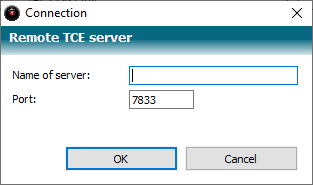
Enter the name or IP number of the computer with the TCE server installed. The connection is made over the specified port.
Local server
The connection is made to the TCE server of your own computer.
Exit
The application is shutting down.
Menu Settings
Local TCE-Projects
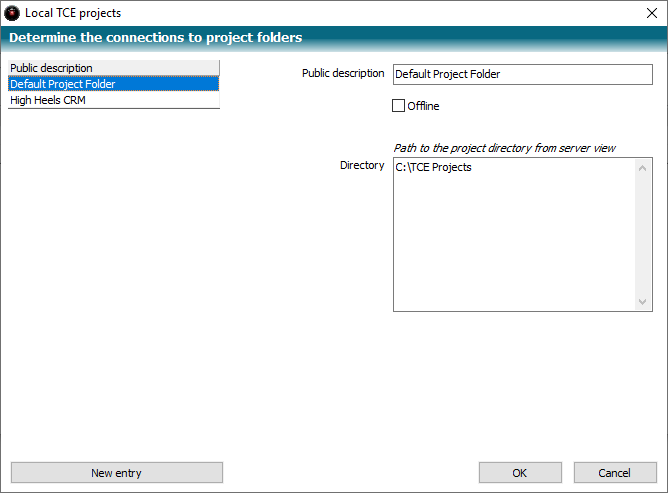
Here you can enter the public names of TCE projects.
The Directory field specifies the root directory of the files and folders of the various knowledge bases that are stored on the computer. A network path is allowed.
Offline:
If the entry is taken offline, TCE Client or TCE Develop will no longer be able to connect to this project directory.
Local physical program path
The menu item opens in the Explorer the directory of the physical program path of TCE on the computer.
Local publishing directory
The menu item opens the default local publishing directory of the TCE server on the computer in the Explorer.
The default directory can be found at
Program Files (x86)\Common Files\TAP.CON\TCE\pkf
Load Balancing

Load balancing can be switched on by activating the check box Activate load balancing.
This window can be used to specify which computers to forward a connection request to when the maximum memory usage of the specified computer has been exceeded.
In the Server column, you specify the computer name or IP number of the computer whose TCE server is to be involved in load balancing.
The current memory usage data is retrieved using the port number of the computer specified in the Monitor Port column. The default port number here is 7833.
The connection request is forwarded using the port number specified in the Port column. The default port number here is 7831.
The Active switch can be used to exclude a computer from load balancing if necessary.
By specifying maximum load (percent), you specify the limit at which memory usage a computer should no longer use for the connection request, and instead find another computer. The list is processed from top to bottom.
Server resided connection definitions

You can use the server-side connection definitions to define a consistent definition of connections to a TCE server for all clients.
Local ODBC settings
The menu item opens the ODBC settings of the Control Panel.
Language
To set the dialog language of the application.
Menu License
License server
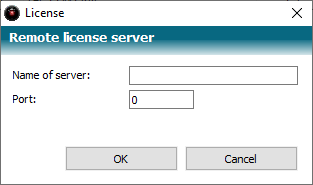
Enter the name of a remote license server. The licenses for the operation of the local server are then obtained from this computer.
Enter the computer name or IP number and port number.
The default port for the license query is 7832.
Request license
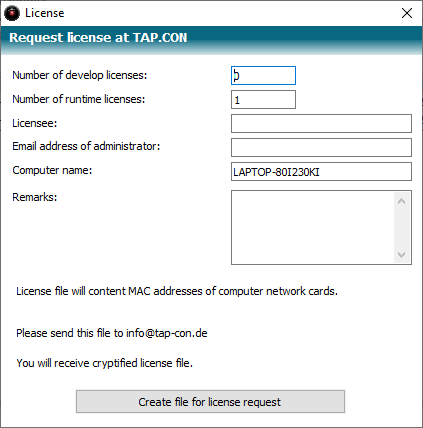
Please specify the number of development and runtime licenses required.
Enter the licensee's name, email address, computer name, and comments, and send the file to info@tap-con.de.
You will then receive a file ending in tcelic, which you can use to replace the license.
Import license
Import the tcelic file that you have received after requesting a license from this menu item.
Prolong license

Shortly before the license expires, you will receive a license key to renew the server license. Please enter this license key here.
License information
The dialog displayed shows the actual used licenses of the server.
Menu Updates
Check for updates
Check and, if necessary, install updates to the computer that you specified in the update settings.
Configure updates
Check the update settings here.
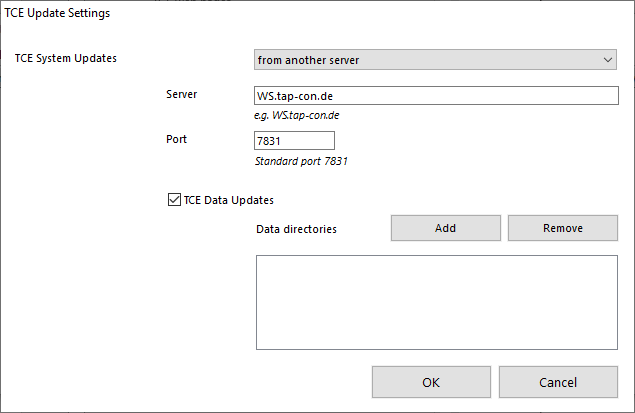
Provide a computer name or IP number of a computer that you want to use to purchase updates. In principle, any TCE server can be used as an update server.
Set what types of updates you want to receive. If the TCE Software Updates switch is set, changes in the program files are checked by TCE and these modified files are transferred and installed.
The Data Updates switch allows you to query additional files and directories from the update server and have them updated on your computer.